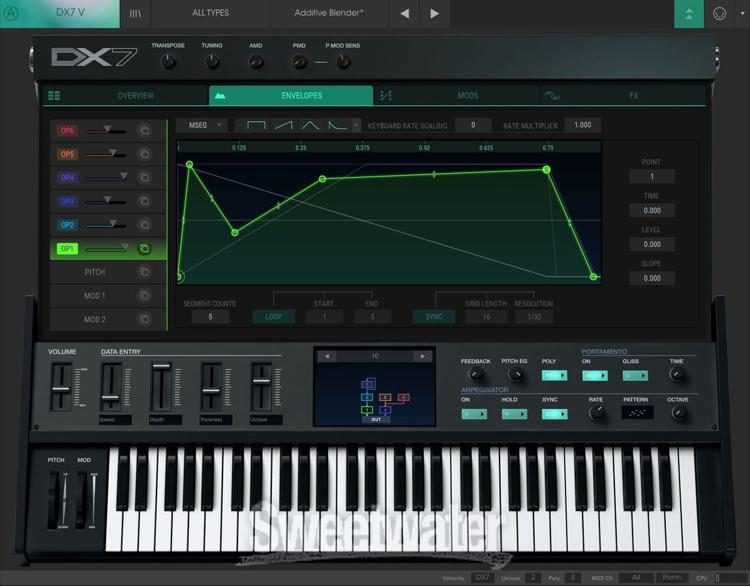

- #IMPORTING DX7 PATCHES INTO FM8 MANUAL#
- #IMPORTING DX7 PATCHES INTO FM8 PATCH#
- #IMPORTING DX7 PATCHES INTO FM8 WINDOWS#
Nevertheless, FM8 is a hell of a synth, and like the hardware instrument that it's based on, it perfectly complements the countless analogue instruments you probably already own. The facility to use sampled waves as carriers or modulators seems an obvious one to include - in fact, it's already available in rival products. If we have one complaint, it's that NI has passed up the opportunity to add an SY99-style waveform import feature. Not only does an excellent selection of presets come included, but you can also import SysEx data from practically every FM synth Yamaha ever made. To be honest, though, you may never need to roll your own patches.
#IMPORTING DX7 PATCHES INTO FM8 MANUAL#
Given that there are nearly 1000 onboard presets, you'll be glad to have the Attributes page - this enables you to embed patches with meta information and categorise them by genre, articulation, instrument type and more.įM7 was always going to be a hard act to follow, but its successor is even better.įM synthesis will never be the easiest concept to grasp, but FM8's clear interface and Easy page should enable even the greenest would-be synthesis to craft unique patches, and a surprisingly informative manual is on hand if you get lost. There's an integrated Kore Browser, complete with categories and a ratings system. Peke FM7 to be able to re-name these editors and re-save before importing into FM8. Speaking of controllers, it's no surprise that FM8 is fully compatible with NI's Kore system. The 10 best synth presets in history (and where you can hear them). You can have a lot of fun controlling the Morph grid with the knobs on your MIDI controller. Judicious use of this enables the creation of everything from slowly evolving soundscapes to sounds that violently rip through the assigned patches. The Morph section, however, is entirely new.Ĭomprising a familiar X/Y vector grid, the Morph function enables you to assign different patches to each of the four corners and crossfade among them to create timbres that change over time. It is also possible to save a single program into a different sysex file.

Can load/save any DX7/TX7 sysex programs. Each operator have a realtime VU meter to know which one is active.
#IMPORTING DX7 PATCHES INTO FM8 PATCH#
This means that you can use this with a native DX7/TX7 as a patch editor. It is probably still one of the best synths on the market and I wouldnt be surprised if it is being used by major studios. It beats the hell out of most of my synths and truly competes with my Prophet 08 and Jd-800. Like FM7's Easy page, this presents you with basic editors for the commonly used parameters (eg, LFO rate, ADSR envelopes and effects). Fully supports DX7 input and output Sysex messages including controller change. No reviews since a few years Well I finally bought into FM8. One noteworthy addition, though, is the Easy/Morph page.
#IMPORTING DX7 PATCHES INTO FM8 WINDOWS#
Some of FM8's windows are certainly familiar, though they have been slightly rearranged. It's also your gateway to the 32-stage envelopes, key scaling, spectrum display, modulation matrix and LFOs. The bottom half of the navigator is tied into the Expert page and gives you access to the operators themselves. All of the usual suspects are in place, as are some complete amp cabinet simulations. The Effects page, however, is worthy of special mention.Īs in other NI products such as Reaktor and Kontakt, the effects are presented in a simple drag and drop rack. The pages include Browser, Attributes, Master, Effects, Arpeggiator, Morph and Expert, most of which are self-explanatory. This time around, the instrument comes in white and pale grey and features a navigator attached to its left-hand side that enables you to choose the editor page you want to work with. FM7 certainly made the programming process a bit less taxing, but FM8's cleaner, clearer interface makes it easier still. In its heyday, FM synthesis left many potential sound designers scratching their heads. The power of FM synthesis lies in the way you can use one or more of these operators to modulate any or all of the others to create new sounds. Though the original DX7 was limited exclusively to sine waves, FM8 offers 32 different waveforms - as a result, its sonic palette is considerably wider. For those few who don't know, Native Instruments' take on Yamaha's flexible but flummoxing form of FM is based on a sextet of operators, each of which has a selectable waveform.


 0 kommentar(er)
0 kommentar(er)
